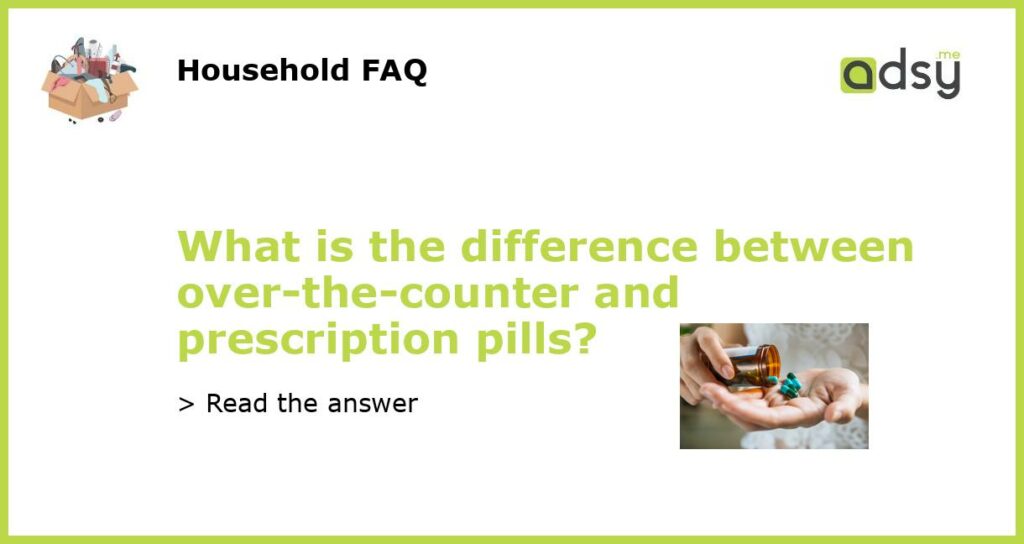Understanding Over-the-Counter and Prescription Pills
Over-the-counter (OTC) and prescription pills are two types of medications that are used to treat various health conditions. While both types of pills serve the purpose of providing relief and managing symptoms, there are several key differences between the two. In this article, we will explore the distinctions between OTC and prescription pills, including their accessibility, regulations, and potential risks.
Difference #1: Accessibility
One of the primary differences between OTC and prescription pills is their accessibility. OTC pills are readily available for purchase without a prescription and can be found in pharmacies, supermarkets, and convenience stores. They are typically labeled with clear instructions and can be easily self-administered by the consumer.
On the other hand, prescription pills can only be obtained with a valid prescription issued by a healthcare professional such as a doctor or a pharmacist. These medications are usually more potent or have a higher risk of side effects, requiring medical supervision and monitoring. The accessibility of prescription pills is limited to licensed pharmacies and healthcare facilities.
Difference #2: Regulations
Another crucial difference between OTC and prescription pills lies in the regulations surrounding their availability and use. OTC pills undergo less stringent regulations as they are considered safe and effective for self-administration when used as directed. The United States Food and Drug Administration (FDA) regulates OTC medications to ensure their quality, labeling, and safety.
Prescription pills, on the other hand, are subject to stricter regulations due to their potential risks and stronger effects. The FDA requires extensive testing and clinical trials to approve prescription drugs before they can be prescribed by healthcare professionals. These regulations are in place to mitigate potential health risks and ensure the safe use of prescription medications under medical supervision.
Difference #3: Purpose and Strength
The purpose and strength of OTC and prescription pills also differ significantly. OTC pills are generally intended for the relief of mild to moderate symptoms or minor health conditions, such as headaches, allergies, or heartburn. They are formulated with lower doses of active ingredients and are considered safe for short-term use without medical advice.
On the other hand, prescription pills are designed to treat more severe or chronic conditions that require stronger and more targeted medication. These medications may contain higher doses of active ingredients or combinations of drugs tailored to specific health conditions. The strength and dosage of prescription pills are determined based on individual patient factors, such as age, weight, medical history, and the severity of the condition being treated.
Difference #4: Risks and Side Effects
Risks and potential side effects are inherent in both OTC and prescription pills, but they differ in terms of their severity and likelihood. OTC pills are generally considered safe when used as directed, and serious side effects are relatively rare. However, users should still be aware of potential risks and pay attention to any warnings or precautions listed on the packaging.
Prescription pills, on the other hand, carry a higher risk of side effects, including potentially severe or life-threatening reactions. These medications often come with detailed information leaflets outlining potential risks, contraindications, and interactions with other drugs. The use of prescription pills requires close monitoring and communication with healthcare professionals to minimize risks and ensure the appropriate dosage and duration of treatment.
Difference #5: Cost
The cost of OTC and prescription pills can vary significantly. OTC pills are generally more affordable and accessible due to their availability without a prescription. The prices of OTC medications are often regulated and competitive, allowing consumers to choose among various brands and generic options.
Prescription pills, on the other hand, can be more expensive due to the additional costs associated with medical consultations, prescription fees, and the higher production and testing standards. The prices of prescription medications may also vary depending on factors such as insurance coverage, brand-name versus generic alternatives, and discounts or assistance programs provided by pharmaceutical companies.






